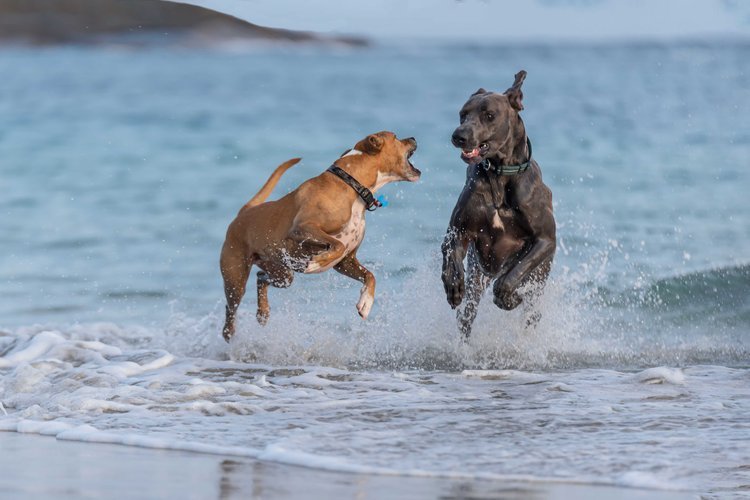Pawsitively Playful: A Guide to Safe Doggy Playdates
What to consider before the Play Date
Does my dog like other dogs?
Is my dog a puppy who hasn’t met any or many other dogs?
Does size matter? Does breed matter?
Where should we meet?
Before the playdate:
When it comes to setting up playdates for your furry friend, there are a few important things to consider to ensure a safe and enjoyable experience for everyone involved.
First and foremost, make sure your pup is fully vaccinated. If they haven't received all their shots yet, it's best to play in a secure and safe environment, such as your own backyard or the backyard of a vaccinated dog's home.
It's also important to take into account your pup's experience with other dogs. If they are a young puppy and haven't had many or any play-dates, choose their playmates carefully. Young dogs are usually the best choice for playing with young dogs as they have similar play styles. However, some older dogs can be great at gently teaching proper play manners. Just keep in mind, the first year of a puppy's life is critical for setting them up for the rest of their life, so it's important to avoid any negative experiences.
If your dog is an older dog, consider their level of socialization and their fondness for other dogs. If they haven't had much interaction with other dogs or don't seem to like them, it might be best to avoid playdates or allow more time for them to acclimate to another dog with parallel walking before they engage in "free range" play.
Finally, size, breed, and temperament can play a role in choosing play-dates for your dog. In general, dogs of the same size, temperament, and breed tend to understand each other's games and play styles better. For example, bull breeds tend to enjoy wrestling and rough play, while herding or gun dogs often understand the need to play chasey games. Shy dogs might prefer playing with other shy dogs or even confident dogs who understand when to back off. Some big dogs are able to get along well with dogs of all sizes and play styles, so it's not essential to always stick to the same type of dog, but often it can be helpful to start there.
Where should we meet?
When introducing two dogs, it's best to meet them on a walk in neutral territory. This allows the dogs to get used to each other gradually. Walking parallel to each other is much less threatening than meeting face to face. Parallel walking allows the dogs to habituate to each other while just plodding along together. Occasional sniffs of each other may happen during the first few walks.
Where to meet “free range”?
At the play date:
Adequate Fencing
Multiple water bowls
No toys or food/bones left around
Wading Pool if hot outside
No children
Never left alone
It's best to have play dates in a quiet and secure place with adequate fencing, multiple water bowls, and no toys or food left around. If it's hot, a small pool can be provided. Avoid having young children present as they can add too much excitement. It is not unusual for over-arousal in dogs to tipple over to aggression. Plus, it is best you observe your dogs fully for the first few meetings to ensure both dogs are having a good time without the distraction of children. If the other dog is not used to Children, it may be best to keep doggy play dates Children free for the safety of everyone. Ensure collars are removed or use fast, break-away collars. Dogs can easily get their tooth caught in another dog’s collar and this can fast lead to a choking dog. An event like this can be extremely traumatic for all involved and can sour play dates for life.
Happy body language is a sign of healthy play, including loose bodies, equal participation, and enjoyment. If one dog is constantly standing over the other or if a dog looks uncomfortable, it's best to stop play and try again later. Some dogs are just not suited and that’s fine, call it and move on. Find another more suitable dog to play with your dog.
Understanding play
When introducing dogs to each other, it's important to observe their body language. Happy dogs will have loose bodies and will enjoy participating in play, with equal turns of being on top. If one dog is constantly standing over the other and the dog on bottom looks concerned, it's best to stop play and let them relax before trying again. If the behaviour continues, the dogs may not be well suited for each other. A scared dog may have a tucked tail, lower tail position, and have ears back and down. If a dog looks uncomfortable, play should be immediately stopped. You should always be the dog’s ambassador.
It can be difficult for some owners to distinguish play from aggression, which is why having a professional dog trainer on hand can be helpful. A professional can help assess the situation in the moment and determine if the dogs are happy and should be left to continue their play or if intervention is necessary.
Just remember, it is not unusual for a play-date not to work. Sometimes our dogs are just not matched in temperament or play styles. Keep looking for your perfect doggy friend, or just enjoy time with your dog without another dog if that is your doggo’s preference.





